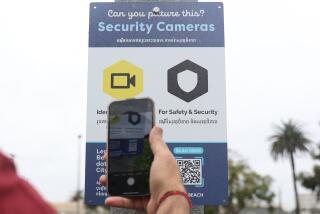He puts parking in its place
Donald Shoup has a quick comeback when people introduce him, as they often do, as the “parking rock star.”
‘Parking rock star’ is an oxymoron, like ‘rap music,’” the UCLA urban planning professor quips, his green eyes twinkling. “Maybe I should change my name to Shoup Dogg.”
Add another moniker for a man who has been hailed as the “prophet of parking,” the “ Jane Jacobs of parking policy” and the inspiration for a Facebook group called “The Shoupistas.”
The last is a fitting term for disciples of the Yale-trained economist, whom many credit with fomenting a long-overdue revolution in parking. At a sprightly 72, he is invited to expound his theories at brown-bag seminars and transportation conferences all over the world, from San Francisco to Sydney, where he’ll speak in November.
Why parking — a mundane, eye-glazing, exasperating aspect of life? (Even Shoup, who finds the subject fascinating, says: “Nothing is more pedestrian than parking.”)
According to Shoup, free parking is at the root of many urban ills: congestion, sprawl, wasteful energy use and air pollution.
City governments contribute to all these ills, he says, by requiring too many parking spaces for all development. The high cost of the required parking increases the prices we pay for everything else, including housing. “We have expensive housing and free parking,” he says. “We have our priorities the wrong way around.”
::
When street parking is free or inexpensive — as in many cities — demand exceeds supply, and people spend time and fuel cruising for scarce spaces. Cheap street parking thus increases congestion by encouraging people to drive rather than walk, pedal or take public transit.
Too many people, Shoup says, have grown conditioned to think like George Costanza, comedian Jerry Seinfeld’s neurotic sidekick on “Seinfeld,” the 1990s sitcom about nothing.
Parking at a garage is “like going to a prostitute,” Costanza intoned in an episode titled “The Parking Space.” “Why should I pay when, if I apply myself, maybe I could get it for free?”
Shoup’s 2005 book, “The High Cost of Free Parking,” for many the de facto bible on the subject, posits a simple-sounding solution: Charge fair-market prices for curb parking. Use the meter revenue to pay for services and enhancements in the neighborhoods that generate it. Eliminate off-street parking requirements.
Cities are starting to listen. Los Angeles, San Francisco, Redwood City, Glendale, Ventura, Portland, Ore., and the District of Columbia are among those implementing or contemplating changes to hew more closely to Shoup’s vision. In an informal poll last year on Planetizen, a planning-related website, Shoup placed 15th on a list of the Top 100 Urban Thinkers. Jacobs, the late New York urbanist known for organizing grass-roots efforts to block urban-renewal projects that would have destroyed local neighborhoods, was No. 1.
“It’s really remarkable how he has become the godfather of this parking idea,” said Ventura Mayor Bill Fulton, who as a UCLA planning student in 1982 took Shoup’s class on public resource economics.
“Don has been saying the exact same thing for 40 years, and finally the world is listening to him.”
Fulton, in fact, said he recently became a full-fledged Shoupista when Ventura implemented a Shoup-style parking management program and quickly saw the intended results. By charging for 400 of the 2,900 public parking spaces downtown, the city has spurred employees of local businesses to park at free city lots and walk to work rather than use curb spaces needed by customers.
Starting in mid-September, Ventura’s meter rates were set at $1 an hour for the first two hours and $1.50 for each hour after that, with the aim of achieving 85% occupancy. Put another way, 85% occupancy — which Shoup considers ideal — would leave one or two open spaces per block. The city said it plans to adjust rates as needed. If parking use drops below 80%, the prices will be lowered until the 85% goal is achieved.
Fulton headed out to get a cup of coffee the morning the program went into effect and wrote in a blog posting: “Only 30 minutes after we instituted the parking management program, it is working.”
::
Born in 1938 in Long Beach, Shoup was 2 when his father, who was in the Navy, moved the family to Hawaii. Home movies taken after the Japanese attack on Pearl Harbor show 3-year-old Don wearing a gas mask decorated with a Mickey Mouse image.
A radio shaped like a parking meter sits in Shoup’s cluttered office on campus. Tomes about parking garages and land use line the shelves of his home office, behind the Spanish-style house in Westwood he shares with his wife, Pat.
Partial to khaki-colored suits and tattersall shirts, Shoup holds four degrees from Yale University, including a doctorate in economics. He has directed the Institute of Transportation Studies at UCLA and chaired the university’s urban planning department.
His earlier work led to passage in 1992 of California’s parking cash-out law, which requires many employers who offer free parking at work to offer commuters the option to take the cash value of a free parking space in exchange for not using a space.
In 1997, Shoup studied eight employers in the L.A. area and found that cash-out programs reduced solo driving to work by 17%. Transit use increased by 50% and carpooling increased by 64%. A bill now in Congress would extend California’s requirement nationwide.
Not everyone subscribes to Shoup’s theories. He recently sparred online with Randal O’Toole, a senior fellow at the libertarian Cato Institute known for his website, The Antiplanner, dedicated to “the sunset of government planning.”
“I am an economist, and as long as Dr. Shoup is thinking like an economist … our thinking coincides,” O’Toole wrote in an e-mail. “It is when he starts thinking like an urban planner, trying to change people’s behavior and in particular trying to reduce driving, that we have a problem. … Mobility is valuable, and any limits placed upon it harm people and the economy.”
Shoup depends on his bicycle for much of his mobility. He freely confesses, however, that when behind the wheel of his silver 1994 Infiniti J30, he often circles the block looking for a free parking space. “I don’t like paying for parking,” he says with a shrug. “But free parking is ultimately not beneficial.”
It’s the conclusion more planners are reaching.
“There’s a sense in a lot of places that parking policy has gone disastrously wrong,” said Patrick Siegman, a principal with NelsonNygaard Consulting Associates, a transportation planning firm in San Francisco. “As people think about it from scratch again, they’re realizing that a lot of old ideas have been a huge failure.”
Shoup considers Siegman the first Shoupista.
He was a student at Stanford circa 1992 when he first discovered Shoup’s monographs in the Green Library stacks. “Because of that experience, I decided to become an economics major, and wrote my undergraduate honors thesis on the economics of parking,” Siegman said. “When I graduated in 1994, I became a transportation planner and started trying to put his principles into practice.”
At a recent meeting of the Glendale Transportation and Parking Commission, Bonnie Nelson, a co-founder of NelsonNygaard, followed Shoup as speaker and cited him chapter and verse.
“Don is treated in some places like Einstein, like he has discovered the theory of relativity,” Nelson said.
::
In Shoup’s view, Old Pasadena and Westwood Village illustrate the effects of different parking policies. In 1993, Old Pasadena installed $1-an-hour meters and began using the revenue to spruce things up. Many area employees who had parked on the street and moved their vehicles every two hours began to pay for parking in city structures, so that curb spaces were freed for customers. The shift helped transform the area from a blighted eyesore into a vibrant destination with shops and restaurants. Shoup doesn’t take credit for Old Pasadena’s change, but he often uses the area as Exhibit A in his talks.
That same year, Shoup said, merchants in Westwood petitioned the city to cut meter rates from $1 an hour to 50 cents. Curb parking was underpriced and overcrowded, and the meter money flowed into the city’s general fund rather than back to the area. Today, Westwood Village residents and merchants bemoan the cracked, trash-strewn sidewalks, neglected landscaping and numerous vacancies.
To Shoup, the matter comes down to a simple question: “Would you rather have free parking and dirty sidewalks or paid parking and clean sidewalks?”






